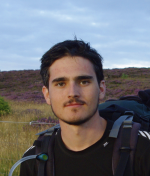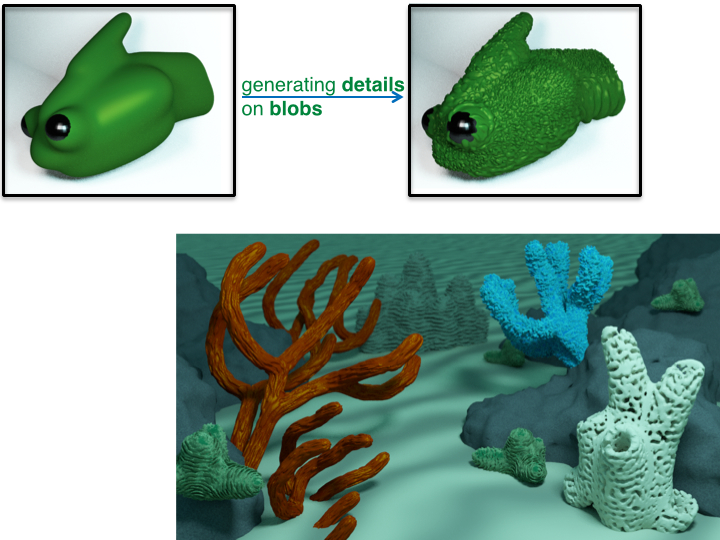
Post-doctoral researcher
I am currently a post-doctoral researcher, member of IMAGINE team at Laboratoire Jean-Kuntzmann and Inria Rhone-Alpes. I am conducting my research under the supervision of Marie-Paule Cani within the ERC Expressive. I am participating in the development of the expressive application and associated C++ library aiming at demonstrating the work done in the context of the ERC expressive in a single framework.
Here is my Curriculum Vitae.
Here is my thesis (in english).
Research
My research interests are all topics that aim at providing easy way to create geometric models and animate them. Until now, I mainly focus on implicit surfaces, a model that enables to easily generate smooth shapes by assembling simple ones. My Ph.D. thesis was mainly focused on convolution surfaces, a subset of implicit surfaces, that enables to generate smooth surfaces form complex graph of skeletons.
 |
Skeleton-based representation presents an intuitive way to represent and manipulate a shape. Convolution surfaces provide a simple way to generate a smooth surface from a graph of skeleton, this is due to their subdivision invariance in respect to the skeleton. However convolution surfaces present some drawbacks such as the difficulty to obtain a prescribed radius around the skeleton, they cause blurring of details and finally they are not scale-invariant. By introducing an extension of convolution surfaces that presents scale-invariance, we have been able to remove the other problem as well. The new model is called Scale-invariant integral surfaces (SCALIS). |
 |
Blending control : Preventing unwanted topology changes is one of the main challenge to which implicit surfaces are confronted. While gradient blending provide a binary operator that solve the problem for arbitrary implicit surfaces, it is not well adapted to integral surfaces since it breaks their subdivision invariance. We introduce a method inspired by gradient blending which is specially adapted to Scale-invariant integral surfaces. |
 |
Generating small scale details : While skeletons are a good representation to represent the main features of a shape, they are not necessarily well adapted to represent surface details. We have studied the generation of surfaces details that are defined coherently with the underlying shape by using skeleton information and behave correctly in the blending regions. This method is based on Gabor noise. |
 |
3D manga hair : In additions to studying the geometrical model itself, I also investigate some new applications of SCALIS, namely the generation of volume manga hair. |
Teaching
I was moniteur at the Ensimag school during my Ph.D. I have taught both mathematics and informatics in Grenoble INP, a group of French engineering school. (Details can be found below.)
Background
- (currently) Postdoctoral researcher, Grenoble University, France
- 2013 Ph.D. in Computer Graphics (speciality mathematics-informatics), Grenoble University, France (advisor: Marie-Paule Cani)
- 2010 Master of Science in Applied Mathematics, Grenoble University, France
- 2010 Graduated from french Engineering school (Ecole National Supérieur en Informatique et Mathématique de Grenoble), France
- 2007 French Preparatory school MPSI, MP at Lycée la Martinière Monplaisir (Lyon), France
Publications
Here is the list of my publications:
Teaching details
My teaching was divided between mathematics and informatics. My 192 hours of teaching were done for various educational level and spread on 3 years.
| 2010-2011 | CPP |
TP : introduction to computer science (BAC+1, CaML) : 22h |
| GI |
TP programming (BAC+3, JAVA) : 15h |
|
| Ensimag |
Software project in C (BAC+3, implementation of a jpeg decoder ) : 24h Algorithms & data structures (courses/TD) : 3h (BAC+3, replacement) |
|
| 2011-2012 | CPP |
TP : introduction to computer science (BAC+1, CaML) : 22h |
| Ensimag |
TD : Mathematical analysis for the engineer (BAC+3) : 18h |
|
| 2012-2013 | Ensimag |
TD : Mathematical analysis for the engineer (BAC+3) : 18h |

